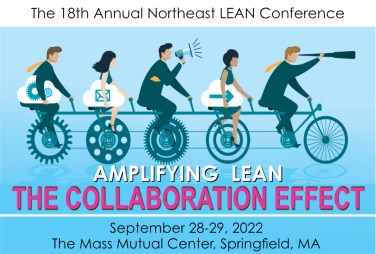With GBMP’s 18th Annual Northeast Lean Conference on the horizon, I’m reflecting on our theme, “Amplifying Lean – The Collaboration Effect.” The term ‘collaboration’ typically connotes an organized attempt by unrelated, even competitive, parties to work together on a common problem; for example, the NUMMI collaboration between GM and Toyota or the international space station. In a sense, these types of organized collaboration are analogs to Kaizen events and significant organizational breakthrough improvement.
Being a longtime proponent of ‘everybody everyday’ type Kaizen, however, I think the greater amplification to our continuous improvement efforts lies in our ability to work together in the moment to solve many small problems. But, just as intermittent stoppages on a machine may be hidden from consideration, so too these on-the-fly opportunities for collaboration may pass without notice. An example from my own career as a manufacturing manager sticks with me as I consider the importance of everyday collaboration:
Walking through my factory one morning, I overheard a heated discussion between John M. a product designer and Ann C. a team lead from our subassembly department. Both individuals had deep experience in their respective areas – perhaps 25 years each. John was waving an assembly drawing for a particular part as they argued, and Ann was holding the component parts and an assembly fixture. All the elements of production were present: man, method, material and machine (4M’s). What was missing was collaboration.
“If you’d just follow the assembly drawing, there’d be no problem,” John argued.
“What?”, Ann shot back. “Do you think I’m stupid? Why would I call you out here if that were true?”
This was the general tenor of the discussion, each party defensively talking AT the other. Specialization, necessary as it is, often creates invisible boundaries we commonly refer to as silos. When any party ventures beyond those boundaries, it’s viewed as an invasion of turf. As the argument continued, the resolve of each party only increased.
I inserted myself into the discussion. “Why don’t we observe the assembly process and drawing together? I’d like get a better perspective on the problem.” John and Ann reluctantly agreed. What seemed to me like an obvious opportunity to understand was, for each of them, possible exposure that one of them would be wrong and lose face. Philosopher James P. Carse refers to this interaction as a ‘finite game.’ Somebody wins and somebody loses. I recall saying something trite like, “Aren’t we on the same team here?” Truth be told, we weren’t. At least, however, we were all in the same space observing the 4M’s together.
Ultimately, John and Ann began to attack the problem rather than each other and, in fact, pulled a parts buyer and a tool maker into the investigation. Working together they uncovered a series of contributing factors involving each of the 4M’s. No single perspective would have been nearly as effective. The errant assembly problem was solved. But more importantly, collaborative relationships were created. James P. Carse would call that an infinite game; everyone wins.
O.L.D.
PS This year’s Northeast Lean Conference will examine collaboration from every angle. Top-down, bottom-up, horizontal, networked, virtual, intercompany, governmental and societal. The “Collaboration Effect” touches every system and every interpersonal relationship. I hope you can join us on September 28-29 (face-to-face or live-streamed) as we explore better ways to work together. It’s just six weeks away – sign up today!



